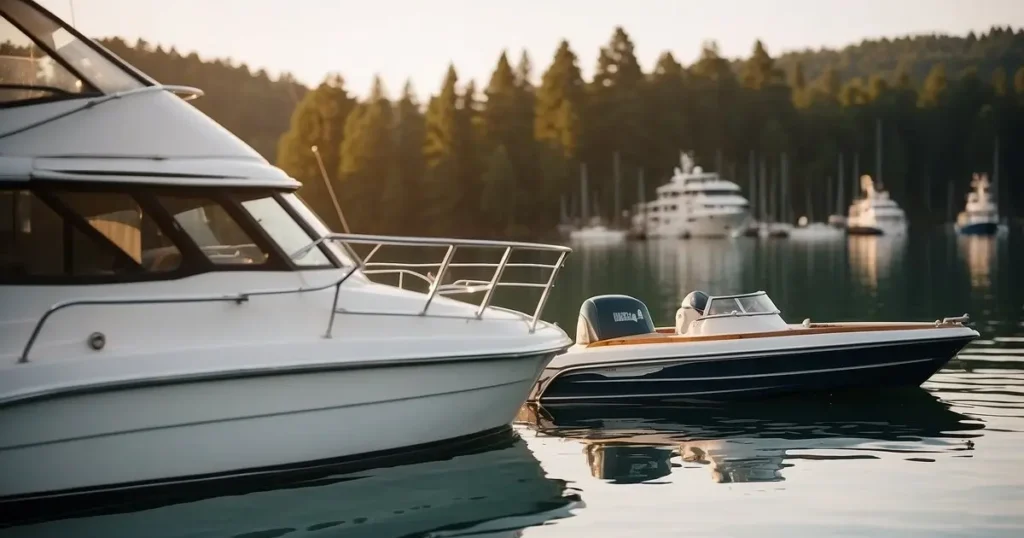
The suitable motor for our Boat is essential for optimal performance and safety. A “boat to motor size chart” can be a valuable tool to help us match our Boat’s specifications with the appropriate horsepower. It’s essential to consider factors such as the Boat’s weight, hull design, desired speed, and the capacity it needs to carry.
The right balance of power and weight ensures that we maintain efficiency and control of the water. An underpowered boat will struggle with performance, whereas an oversized engine can put undue strain on the hull and even be unsafe. Moreover, adhering to manufacturer recommendations and capacity guidelines is crucial for our Boat’s safety and longevity.
Understanding the dynamics of our Boat’s performance helps us make informed decisions about the best motor size for us. It might be tempting to opt for more horsepower, but the key is finding the engine that aligns with our boating needs and complies with safety regulations. This ensures enjoyable and secure experiences on the water every time we sail.
Understanding Boat and Motor Specifications
When planning your perfect boating experience, a boat to motor size chart is essential to pair your Boat with the ideal motor. Let’s dive into how boat size, weight, and type, along with the motor’s horsepower, play pivotal roles in your Boat’s performance.
Determining Boat Size and Type
Boat size is commonly expressed in terms of length and weight. Smaller boats like a canoe or a Jon boat may only require a small outboard motor. Larger vessels, such as pontoon boats or sailboats, demand more powerful engines to produce the necessary thrust. For example, a 17-foot aluminum boat typically requires an engine with a horsepower (HP) range of 25 to 60HP for efficient operation.
- Jon Boat: 25-40 HP
- Pontoon Boat: Up to 300 HP
- Canoe: 2-4 HP
Motor Sizing Basics
Outboard motors are available in various sizes, and their power is rated by horsepower. Maximum horsepower is critical, often determined by the Boat’s size and type. It is vital to avoid overpowering or underpowering your vessel, as it affects handling and safety. A helpful rule is to have one horsepower for every 25-40 pounds of boat weight for an optimal balance of speed and control.
- Motor HP Range:
- Small Boat (up to 16 ft): 15-75 HP
- Medium Boat (16-20 ft): 75-200 HP
- Large Boat (over 20 ft): 200 HP and above
Deciphering the Capacity Plate
The capacity plate on a boat gives you the manufacturer’s recommended guidelines for maximum horsepower and weight, ensuring you don’t exceed safe operating conditions. It is commonly found near the Boat’s helm or transom and should be consulted when selecting a motor.
- Capacity Plate Information:
- Maximum Horsepower: The highest safe horsepower for your Boat.
- Maximum Weight: The total weight includes passengers, gear, and motor your Boat can safely carry.
Understanding and adhering to these specifications is not just about compliance; it’s about enjoying a safe and pleasant time on the water with the confidence that your Boat and motor are well-matched.
Our Boat to Motor Size Chart

When selecting the appropriate motor size for a boat, there are general rules of thumb to consider. These rules are based on the weight of the boat and its length. Below is a simplified chart that outlines the recommended motor size for different boat sizes and weights. Please note that these are general guidelines, and it’s always best to consult the boat manufacturer for the most accurate recommendations.
| Boat Length (ft) | Boat Weight (lbs) | Recommended Motor Size (hp) |
| < 16 | < 1,000 | 15 – 20 |
| 16 – 18 | 1,000 – 2,000 | 20 – 40 |
| 19 – 22 | 2,000 – 3,000 | 40 – 75 |
| 23 – 26 | 3,000 – 4,500 | 75 – 115 |
| 27 – 30 | 4,500 – 6,500 | 115 – 150 |
For example, a simple calculation based on weight suggests having one horsepower for every 25-40 pounds of boat weight. This means a 2,000-pound boat might require an outboard motor between 50-80 horsepower. However, it’s also essential to consider the boat’s usage, as different activities might require different power levels. For instance, boats used for water sports might need more power for better performance.
Refer to the boat manufacturer’s recommendations or consult a professional to ensure you choose the right motor size for your specific boat and intended use.
Selecting the Right Motor for Your Boat

When examining a boat to motor size chart, we’ll discover that pairing the correct outboard motor with our boat size is crucial for optimal performance.
Importance of Appropriate Horsepower
Selecting the correct horsepower for our Boat isn’t just about speed, safety, and efficiency. The right amount of horsepower will balance the Boat correctly, avoiding the risks of overpowering or being underpowered. An underpowered boat can struggle with maneuverability, while an overpowered one can be a safety hazard.
Comparing Outboard Motor Sizes
It’s essential to understand the differences between 2-stroke and 4-stroke engines. Generally, 4-strokes are heavier, more fuel-efficient, and quieter, whereas 2-strokes are lighter and sometimes more powerful. This comparison will help us make informed decisions about outboard motor size.
Impact of Motor Power on Performance
A motor’s thrust and horsepower will directly impact the Boat’s ability to control and maneuver. An engine that is too powerful may make the vessel hard to handle, while one that is not powerful enough will make it lack responsiveness. We must ensure the power complements the Boat’s size for a smooth experience.
By following these guidelines and referring to a detailed boat to motor size chart, we can ensure that our experience on the water is enjoyable and safe.
Motor Features and Considerations
When we look at a boat to motor size chart, it’s crucial to consider the specific features of boat motors. These details can affect everything from performance to maintenance needs.
Understanding Shaft Length and Type
For optimal performance, the shaft length should match the transom height of your Boat. This ensures the propeller is submerged at the proper depth. There are typically three shaft lengths:
- Short Shaft: For transoms up to 15 inches
- Long Shaft: For transoms 16 to 20 inches
- Extra Long Shaft: For transoms 21 to 27 inches
The right type, whether a standard shaft for recreational use or a sailboat shaft for higher thrust at lower speeds, can make a significant difference.
Motor Types and Fuel Efficiency
Motor types mainly include 2-stroke and 4-stroke engines. Here’s a quick comparison:
- 2-Stroke Engines: Typically lighter and offer a higher power-to-weight ratio but are less fuel-efficient and might need to meet specific emission standards.
- 4-Stroke Engines: Known for better fuel efficiency and meeting stringent environmental regulations, though they can weigh more.
Your fuel tank’s fuel type and size also determine how efficiently you can use your motor. For More thrilling information regarding Motor Types and Engines, check out our article about Speed Boats here.
Maintenance and Longevity Tips
To ensure the longevity of your motor and maintain its warranty, follow these pointers:
- Regular Maintenance: Check the owner’s manual and maintain a schedule.
- Cleanliness: Keep both the motor and fuel tank clean to prevent issues.
- Professional Check-ups: Have a professional inspect your motor periodically.
Remember that the engine size and how diligently you follow these tips can also impact the longevity of your Boat’s motor.
Safety, Regulations, and Additional Equipment
When determining the best fit from a boat to motor size chart, it’s important to consider regulations and safety for an optimal boating experience. We’ll ensure our vessel is Coast Guard compliant, assess necessary onboard equipment, and consider additional features to elevate our time on the water.
Adhering to Safety and Coast Guard Standards
Safety should always be our top priority on the water. Meeting the Coast Guard regulations corresponding to our boat size is crucial. For boats between 16 and 65.6 ft, regulations demand specific types and quantities of Personal Flotation Devices (PFDs) and a Throwable Type IV device for each passenger.
Any watersports activities also require additional safety gear. Learn more about these requirements to ensure the safety of everyone onboard.
Assessing Necessary Boating Equipment
Besides safety gear, our Boat’s size also influences essential equipment requirements for an efficient trip. For instance, boats shorter than 39.4 feet must carry an effective sound-producing device, and those longer but less than 65.6 feet need a bell and a whistle.
Also, consider the type of fuel delivery system and the presence of any vibration or noise, which are essential for both safety and the Boat’s performance. Ventilation is another mandate for vessels after April 25, 1940. Review additional equipment details.
Considering Additional Features for Enhanced Experience
Lastly, while sticking to a budget, we can explore extra features like a trolling motor for quiet propulsion or specialized gear for fishing. Such additions can improve our experience and keep noise and vibration minimal. Remember, while adding equipment, balance your Boat’s size and motor capacity to maintain optimal performance and prevent overloading.
FAQ – Boat to Motor Size Chart
Regarding boating, ensuring the correct motor size is crucial for safety and performance. Here, we discuss using a boat to motor size chart to find the ideal match for your vessel.
How do I know what size motor I can put on my Boat?
The motor size you can put on your Boat primarily depends on the Boat’s weight and type. A good starting point is to consult a boat horsepower chart, which can help you determine the horsepower per pound ratio you need for the weight of your Boat.
Remember the manufacturer’s recommendations and the capacity plate on your Boat, if available, to ensure compliance with safety regulations.
Can you put any size motor on a boat?
No, you cannot put just any size motor on a boat. Overpowering or underpowering can be hazardous and may violate boating laws. There’s typically a maximum allowable horsepower for each boat model, specified by the manufacturer, which should be adhered to.
To determine the ideal range, use resources like a detailed motor size guide tailored to your Boat’s specifications, including its length, type, and weight.
What are the two different-size motors on a boat for?
On boats with two motors, often called twin engines, the primary purpose is redundancy for safety and improved handling. If one fails, the other can operate with twin engines, getting you back to shore safely.
Additionally, two engines can provide better maneuverability and sometimes more speed. They’re usually seen on larger boats where a single motor might need to provide more power or on vessels intended for offshore fishing, where reliability is critical.
The article covered boat to motor size chart fundamentals, but real-world experience tops any guide. Share your Boat experiences, successes, failures, or tips in the comments below to help fellow boaters.

